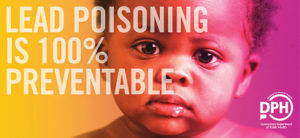 Lead
Lead
Lead is a naturally occurring element that has been used in many products including paint, ammunition, old plumbing and solder, wires and batteries. Although lead was banned from use in household paints in 1978, houses built before that year may contain hazardous lead-based paint. Child-specific products such as toys and dishware have also been identified as violating the lead standards set by the U.S. government.
Lead can be a dangerous contaminant, especially for children. Once a child has been poisoned by lead, the impairment it may cause is irreversible. Lead harms children’s nervous systems and is associated with reduced IQ, behavioral problems, and learning disabilities. In large doses, it can cause coma, convulsions, and death. The most common source of lead exposure is through ingestion. This is can happen two ways: either direct ingestion or ingestion of dust that contains high levels of lead.
LLHD Sanitarians enforce the State of Connecticut Childhood Lead Poisoning Prevention Regulations. When we receive a report of elevated blood lead levels, we initiate an investigation to determine how and why the individual has been lead poisoned. Specific attention is given to children, who are affected more severely by elevated blood lead levels than adults. For more detailed information concerning lead please contact Katie Baldwin, Lead Sanitarian.
For Parents/Guardians
Did you know that by law, your children must be screened for lead twice before age 3 (typically at their 1 and 2-year check-ups)? In 2009, the State of Connecticut adopted universal screening requirements to help protect children from this hazardous metal. Parents are encouraged to ask their primary care providers what their children’s specific lead level is. Children with a blood lead level of 3.5 μg/dl or higher should be monitored to make sure the level does not increase. Lead levels below 3.5 μg/dl can still put your child at risk for health effects, including reduced IQ, trouble paying attention, and increased aggression. There is no “safe” blood lead level! Consult your doctor for more information regarding scheduling testing for your children. See the Helpful Resources section below for more information regarding developmental milestones and other lead safety information.
For Homeowners & Landlords
Did you know that defective paint on your property can pose a lead hazard to you or your tenants? If your house was built before 1978, it may contain lead-based paint. Chipping and peeling paint can be ingested by small children. Lead-contaminated dust can be ingested or inhaled. If you are doing a renovation, repair, or painting project on paint (interior or exterior) that may contain lead, we encourage you to consult this working lead safe document and remember the following:
1. Keep it wet. Dust is the enemy!
2. Wet scrape, never sand!
3. Contain the work area with the appropriate plastic coverings.
4. Never allow small children access to worksites.
The EPA’s Lead Renovation, Repair and Painting Rule (RRP Rule) requires that firms performing renovation, repair and painting projects that disturb lead-based paint in homes, childcare facilities or pre-schools built before 1978 be certified by the EPA (or an EPA-authorized state), use certified renovators who are trained by EPA-approved training providers, and follow lead-safe work practices. For more information or to find an EPA-certified firm visit the EPA’s website or the State of Connecticut Department of Public Health’s database.
Landlords, when notified by your tenants regarding defective paint, proper precautions should be put into place to prevent lead poisoning from occurring. This includes hiring an EPA-certified RRP firm to stabilize the suspected lead base paint, providing information to the tenants regarding known lead hazards in the home, and correcting defective surfaces in a timely manner. Failure to act accordingly may result in a child becoming lead poisoned at your property.
Helpful Resources
- Know the Facts (in English) (en Espanol)
- Make Healthier Choices (in English y en Espanol)
- Well Fed = Less Lead (in English) (en Espanol)
- EPA’s RRP: Renovation, Repair & Painting Rule
- Lead Poisoning Prevention Fact Sheet
- Safe Lead Practices. Learn about lead-safe practices and how to control lead hazards in your home. This information is especially important if you live in a home built before 1978.
- Sign up for Public Health Alerts, and we’ll email you when a product has been recalled due to lead hazards.
- Product Recall Information. Learn about lead contamination and how to avoid and assess the danger to your children.
- Developmental Milestones–Birth to 3 years: (in English) (en Espanol)
- Lead Poisoning Prevention Info for Parents: (in English) (en Espanol)
- Lead In Drinking Water Fact Sheet
- Eating Right Helps Prevent Lead Poisoning
- Questions and Answers about Lead in Toys. Learn more about lead contamination in toys and download a list of labs certified to test toys and other products for lead. Or use the Consumer Action Guide to check for lead in toys you already have.
- Reducing Lead Hazards in the Home: A Guide for Parents and Homeowners
- Considering a home lead test kit? The Consumer Product Safety Commission warns that these test are not effective at accurately identifying lead hazards. Read the CPSC press release to learn more: CPSC Lead Tests Press Release
- Check the State of Connecticut Department of Public Health’s database to see if your contractor is licensed to conduct lead inspection and abatement activities.
- More information on lead is available from the EPA and the DPH websites.
Kid-Friendly Resources
- Lead Prevention Activity Book: Get Ahead of Lead
- Lead Prevention: Leadie Eddie Coloring Book
